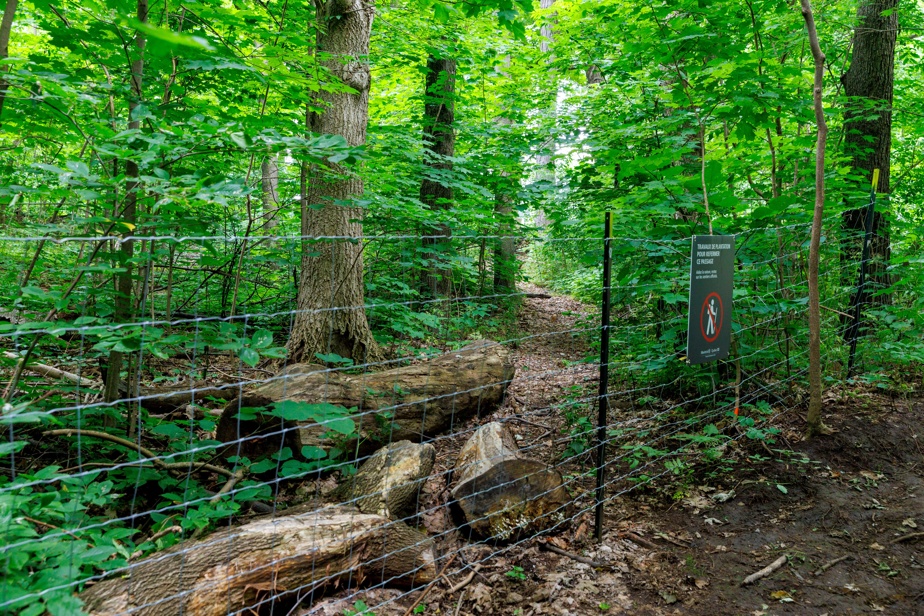A fence was cut down to gain access to a prohibited path in Mount Royal Park. On the other side are hidden plants that are endangered and very rare in Quebec; the City of Montreal and the organization Les amis de la montagne have been fighting for several years to protect them from malicious or careless visitors who trample them.
The mountain is home to a multitude of endangered species. The bloodroot, the large-flowered uvularia, the white trillium and the ostrich fern are plants closely monitored by the City of Montreal.
One of the plants that attracts the most attention is the podophyllum peltatum, a plant so rare in Quebec that the exact location of the populations is kept secret by Les amis de la montagne and the City of Montreal.
-

PHOTO NORMAN DIGNARD, PROVIDED BY THE MINISTRY OF THE ENVIRONMENT, THE FIGHT AGAINST CLIMATE CHANGE, WILDLIFE AND PARKS
Peltate podophyllum
-

PHOTO ALAIN ROBERGE, THE PRESS
The Bloodthirsty of Canada
-

PHOTO ALAIN ROBERGE, THE PRESS
Large-flowered uvularia
1/3
The City of Montreal and Les amis de la montagne carry out inventories of these specimens several times a year.
These are such small populations and there are so many people on the mountain that it doesn’t take much to wipe out populations.
Antonin St-Jean, head of conservation services for Friends of the Mountain
According to the most recent data from the City of Montreal, Mount Royal Park is visited by more than 7.5 million people each year.
The initiatives
Along the roads, fences have been installed since 2021 as part of a vast program to close informal trails, reports the City of Montreal.
The park underwent two further phases of fencing in 2022 and fall 2023, preventing the advance of several kilometers of informal trails.

PHOTO ALAIN ROBERGE, THE PRESS
The head of conservation services for Les amis de la montagne, Antonin St-Jean, notes that a fence has been cut down, allowing access to an informal trail.
The aim of this project is to rebuild the park’s flora and protect plants at risk.
However, the city’s initiatives do not scare the recalcitrants who are ready to cut down fences and remove warning signs in order to use prohibited paths or to pick plants from the park, an illicit activity.

PHOTO ALAIN ROBERGE, THE PRESS
Antonin St-Jean, head of conservation services for Friends of the Mountain
There was someone who would come in two or three times in the spring every year and he would harvest fiddleheads. If everyone starts doing that, you can wipe out a population quickly.
Antonin St-Jean, head of conservation services for Friends of the Mountain
The City of Montreal indicates that some trails have recently been closed by the planting of native trees and shrubs, an initiative already tested before, confirms Mr. St-Jean.
“For example, in 2018, we closed a trail to plant trees, and a group of people wanted to continue using the trail. They came to uproot the trees and threw them into the forest. We went back to plant them, and they came back with pruning shears to cut down all the plants,” he says.
Disturbances and invasive plants
A toxic herbaceous spring plant, May-pod is an important source of food for pollinators in the spring. It is easily disturbed by recreational activities and is fragile when trampled.
Lack of awareness or carelessness among park users can be factors that affect endangered plants. This is the case of a family who was borrowing in front of The Press an informal path without knowing that the fence blocking the passage has been cut down. This problem causes confusion among park users.

PHOTO ALAIN ROBERGE, THE PRESS
One of the fences installed in Mount Royal Park to keep walkers out of the planting areas.
“Trilliums bloom during Mother’s Day. Sometimes, through ignorance, people pick trilliums during their walk in the park for Mother’s Day and that can have a considerable impact,” says Antonin St-Jean, for whom environmental protection and education are his main objectives with Les amis de la montagne.
Human activity is not the only threat to these plants. Invasive plants such as garlic mustard, common buckthorn, Russian vine-strangling and wood anthriscus have made their way into the park. The head of conservation services for Les amis de la montagne explains that these are plants that monopolize space, preventing vulnerable plants from spreading.
There has still been an improvement in the reconstruction of the flora in the park since the fences were installed, notes Mr. St-Jean, a member of the non-profit organization for 14 years.
“Once it’s closed, it goes pretty quickly. The plants come to recolonize the trails pretty quickly. There are even trails where you can find white trillium that is starting to take back its place,” says Antonin St-Jean.
The fences were put in place for about four years, which worries Mr. St-Jean. He fears that people will return to the bad habit of creating informal paths: “We don’t want people to start doing that again.”
Write to us to share “your green ideas”
